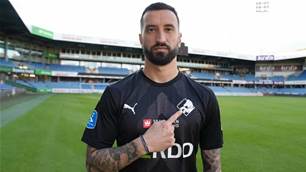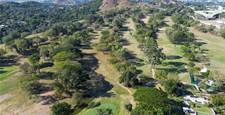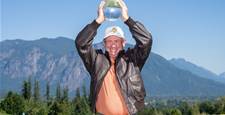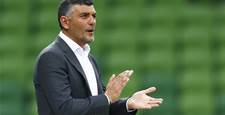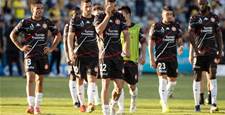EXCLUSIVE: Outgoing national youth coach Jan Versleijen believes more youth games against South American opposition will benefit the Australia in the long-term and says some criticism of him has been “unprofessional”.
Versleijen, 55, finishes his contract with the Football Federation Australia this month.
The former West Asian and Dutch-based coach had a final get-together last week with those he’s worked closest with since starting his tenure in Australia in June, 2008.
The Dutchman had an over-arching role with the FFA but last month – at his prompting – the FFA restructured the job and split the coaching roles for the AIS and Joeys and Young Socceroos.
After an exhausting three and a half years in the development system Versleijen will take a break before heading to China to take on the role of head coach at Henan Jianye in the Chinese Super League.
You’ve had some strident critics, chiefly Craig Foster from SBS TV. How do you respond to what he’s said about your time in Australia?
It’s a little bit of a pity actually that people make those comments without actually knowing what’s going on. I have no problems with people criticizing but visit the games, visit the training sessions, talk to the coach. That’s not just for me but for all coaches. It will give you more insight into what’s actually what’s happening. And don’t make opinions based on TV screens. I don’t think that’s very professional.
FFA, over the next four years, want to become a top ten nation in a ‘football culture’ sense. What’s your take on this vision?
Of course you have to set your goals. And to set goals you have to know what you have to do to reach those goals. You have to have a plan. And what’s happening there the last five or six years there have been some big changes in football in Australia.
But I feel we need to play with our younger national teams more international games. Participating at a World Cup is on its own not good enough. I think people already take it as a given you qualify for a World Cup but I don’t think that’s the case.
Do we need to play more games at youth level against European and South American opposition?
Yeah, absolutely. There’s a lot of progress in youth football but I like to play against South Americans because they make you think. They make you make decisions in moments and they always challenge you. And as soon as they see any weakness in your team they’re going to penalise you.
If you play against European teams, they’re well organised, good structure; probably the challenge against them is to keep the pace and the concentration for 90 minutes. If you lose your concentration then straight away they penalize you. That kind of experience we need more.
A young player playing in the national team needs to play at least 10-15 good international games in a season. I think have benefited a lot from shifting into the AFC competitions that means you play more games and more against different opponents.
Continues on next page...
What’s your advice for the next in charge in the Australian national youth set-up and what sort of person should it be?
Somebody who understands the role on the football side; that means you have to know what kind of things to work on for players from the age of 14 to 17. You have to have international experience because you’re playing in Asia and hopefully qualifying for World Cups.
How does the FFA compare to other bodies you’ve worked with around the world?
Because it’s still a young organization, so they’ve had to do a lot of work to get the football going in Australia. I think they’re doing a great job. Look at the A-League now compared to three years ago when I came for instance and the standard has gone up unbelievably. The quality has gone up, the attendances have gone up, and the quality of players has gone up.
And I believe the FFA can even do more for the youth football. I know they work from top down, but I think also bottom up – which is happening now – I think in that area they have to do even more. When you work top down you can see the results in the short term. When you work bottom up probably the results take longer but they will have more of a better chance to get into the top ten.
How do you look back on your time in Australia?
When I started in June 2008 I started working with the Young Socceroos the first thing that caught my eye were the technical problems that they had. I was very impressed by their mentality and attitude – they have a winning mentality which is very good to have.
Is the reason for that linked with the development of players at a much younger age, you think?
I’m sure because you learn and get your technical abilities when you start when you’re six to eight. And that age, up till you’re about 14 you need a lot of ball contact and you need to get them in the right situations and right environments and you need to be challenged as well as technical and tactical, and in that area we still can get more improvement.
And that’s already happening with the 4-3-4s and Skillaroos program and also with the national curriculum there are already big changes visible from what I can see in the last few years.
With the football, in the beginning you don’t know what to expect but we’ve set up a program using the national curriculum. Also we are using better football conditioning and that’s probably also some good changes.
The AIS was always known for a lot of injuries but nowadays we don’t have any injuries so the approach from the technical and tactical side game related training and the football conditioning side is probably a good choice.
If I compare the first group of Young Socceroos and I compare them to the ones who went out to Malaysia, that’s a big difference. From what I see in terms of the development in 2008 we just managed to qualify for the World Cup in extra time. If you look at the 2009 qualifying, we already played in the final.
Rising star Terry Antonis, talk us through your views on managing him?
Terry I think made the right decision to come to the AIS. Technically he’s unbelievable, left and right foot and has a really good work rate and is a lovely kid to work with. Tactically he probably has to add some more things to his game to use his technical ability even more.
It’s difficult to say how somebody develops but if you are 17 and already playing in the A-League and are one of the better players on that level and if he can continue doing that, probably he has to make the next step. But if you don’t get any challenge at a young age, then you will drop [in standard].
Continued on next page...
So over the next season or two what should be the best plan for him?
When he shows he can easily play in the A-League then he has to make the next step. For every young player you have to make your next step. And some players cannot make the next step so that’s also no problem. They can play 15 years in the A-League and that’s perfect. You have a good professional career [here].
I always talk to the players and say, “Don’t be satisfied with what you’re doing now”. The last few years we had a lot of young players at the AIS now playing in the A-League. Curtis Good, Hamill, Musti, Terry … and that’s no coincidence that they can make the step.
If we watched the Young Socceroos in 10 years time, what type of team will it look like?
If you don’t improve in the area of six-eight to 14 then you always will be behind the other countries. It’s a must if you want to make that next step. Australia at this moment, if you look at their position they are in the top 20 of the world. I think that’s a fair reflection of where we are right now.
The Olyroos, they've strugged to score goals and Olympic qualification is not assured. Your thoughts?
The ones who started a few years ago, a lot of the Olyroos were in the 2008 Young Socceroos U19 squad. They’ve also improved.
If for example you look at Matthew Jurman and I started with him and we had a tournament in Japan and we played against Argentina and I saw the problems he had with playing out from the back and I see him now, it’s a huge improvement.
And that shows also that if you work in the right way with those boys even in the older age, they can improve. But you’d like to get them in [to the development system] better and only improving them in the later stage of their development.
Mustafa Amini, a new type of player coming through and already with a European contract. What does it say about the system?
It’s an interesting question. With all the changes now with identifying players, how to look at players and what kinds of things you’re looking at and the tools you need.
I think Musti wouldn’t have had any chance say five or six years ago to get into the system because he wasn’t fast enough, too small and now we are looking at the awareness and the technical skills and if you look at Musti he has great awareness and feelings to get into positions and feeling about how to protect the ball. He has to add some things to his game to become a better player but for his age, he’s quite good.
There is a saying it’s not that important how fast you are but it’s more important if you at the right moment at the right position. Musti is playing in a number 10 position [for his club the Mariners] so he should be able to get more in front of the goals and he’s proven with the Young Socceroos that he can score goals.
It’s not just about players; talk us through some of the young Aussie coaches you’ve worked with in your time?
From what I hear from people in Newcastle Gary [Van Egmond] came back as a better coach after his time at the AIS. Of course he’d already won a championship with Newcastle so that’s a very good thing.
And Arthur [Papas] is probably one of the younger coaches who is very passionate and also he has a lot of knowledge in football. And I see he can become a very good coach. He has all the attributes to become a very good coach. The ones who work with me one of them is Ante Milicic now working at Melbourne Heart, I also rate him quite high.
What’s the next step in their coaching careers?
It depends on each individual situation. Like Arthur now he’s gone to Newcastle and will take the national youth league team and assist Gary so probably he has to be in that role in a few years and hopefully he can take his next step to become a head coach of maybe Newcastle.
Brisbane Roar, how’d they go in say the Belgian or Dutch leagues?
I think they can manage to play in those leagues. The challenge is always if you play one or two games against that kind of opponent probably you will do well. The challenge is to play a full year. That’s another story. And also the pace especially is higher. They talk many times about the speed of the game in Australia but it depends on how you quantify speed. I think of it as speed of decision, ball speed and the like.
Will you ever return to work here?
You never know in football. It’s difficult to predict. If you told me five years ago that I’d work three and a half years in Australia I couldn’t have known. When you work in world football anything can pop up.
Follow me on Twitter @Aidothejourno
Related Articles
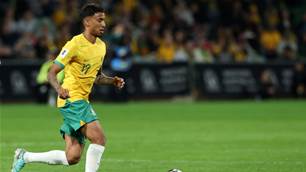
Socceroos midfielder embraces move to England
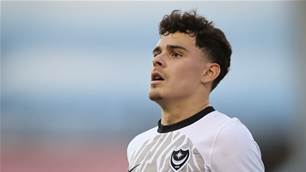
Cardiff City snap up sought-after Socceroos starlet
